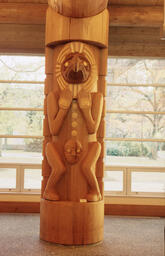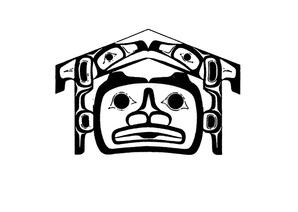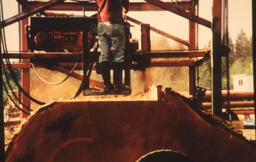Image
The two-sided Beaver and Eagle Housepost sits at the southeast entrance to Sty-Wet-Tan, the Great Hall of the First Nations Longhouse. The two-sided post was carved by internationally renowned Haisla artist, Lyle Wilson. This image depicts the eagle…
Image
The two-sided Beaver and Eagle Housepost sits at the southeast entrance to Sty-Wet-Tan, the Great Hall of the First Nations Longhouse. The two-sided post was carved by internationally renowned Haisla artist, Lyle Wilson. This image depicts the eagle…
Image
The two-sided Beaver and Eagle Housepost sits at the southeast entrance to Sty-Wet-Tan, the Great Hall of the First Nations Longhouse. The two-sided post was carved by internationally renowned Haisla artist, Lyle Wilson. This image depicts the eagle…
Image
The Raven with Spindle Whorle Housepost sits at the southwest end of Sty-Wet-Tan and was carved by Susan Point, a Coast Salish artist from Musqueam.
Image
A view through Sty-Wet-Tan, the Great Hall in the First Nations Longhouse. The Wolf and Wolf Pup Housepost is on the left, and the Man and Raven Housepost is on the right.
Image
A view through Sty-Wet-Tan, the Great Hall in the First Nations Longhouse. The Wolf and Wolf Pup Housepost is on the left, and the Man and Raven Housepost is on the right.
Image
The two-sided Beaver and Eagle Housepost sits at the southeast entrance to Sty-Wet-Tan, the Great Hall of the First Nations Longhouse. The two-sided post was carved by internationally renowned Haisla artist, Lyle Wilson. This image depicts the eagle…
Image
A view through Sty-Wet-Tan, the Great Hall in the First Nations Longhouse. The Beaver and Eagle Housepost is on the left, and the Raven with Spindle Whorl Housepost is on the right.
Image
The Pit House structure as seen from below. The posts extend upward in a design inspired by the pit house structures used as winter dwellings by the Interior Salish.
Image
The Pit House structure as seen from ground level. The posts extend down in a design inspired by the pit house structures used as winter dwellings by the Interior Salish.
Collection
This is a collection of photographs and slides from the UBC First Nations House of Learning Grand Opening ceremony that took place on May 25, 1993. The collection is a mix of photographs and slides from the occasion, and they were digitized by UBC…
Image
Don Yeoman, a Haida/Métis artist carved the two roof beams of Sty-Wet-Tan (the Great Hall). Each beam weighs about 4500 kg, and together they represent Killer Whale and Sea Lion.
Image
Over 1,000 people gathered at the May 25, 1993 Grand Opening of the First Nations Longhouse.
Image
The First Nations Longhouse was constructed using primarily cedar. The logs were milled by Heatherbrae at their processing site near Gibson's Landing.
Image
The First Nations Longhouse was constructed using primarily cedar. The logs were milled by Heatherbrae at their processing site near Gibson's Landing.
Image
The First Nations Longhouse roof was designed to resemble the wings of a bird in flight.
Image
The First Nations Longhouse was constructed using primarily cedar.
Image
Elder Vince Stogan of the Musqueam Nation, Chief Simon Baker of the Squamish Nation, and Elder Margaret White sit during the Grand Opening of the First Nations Longhouse.
Image
The First Nations Longhouse was constructed using primarily cedar.
Collection
This is a collection of images from the construction of the UBC First Nations House of Learning. The collection is a mix of photographs and slides from the occasion, and they were digitized by UBC School of Information students as part of a class…
Image
The actual construction of the Longhouse took 15 months.
Image
The actual construction of the Longhouse took 15 months.
Image
The actual construction of the Longhouse took 15 months.
Image
The First Nations Longhouse was constructed using primarily cedar. The logs were milled by Heatherbrae at their processing site near Gibson's Landing. Some logs were taken from the Eve River on Vancouver Island.
Image
The First Nations Longhouse was constructed using primarily cedar. The logs were milled by Heatherbrae at their processing site near Gibson's Landing. Some logs were taken from the Eve River on Vancouver Island.
























